Don't be afraid of desserts!
Instead of worrying about our nutritionally dangerous deserts
of refined white flour and sugar, let's use our intelligence and creativity
to create desserts that are healthy as well is tasty!

|
Most people consider a “dessert”
to be something that is sweet. There
is nothing wrong with the food that is sweet, but most of the desserts,
at least here in modern America, are nutritionally
worthless. Their primary ingredients are sugar, refined flour,
oil, and artificial flavors. If any of us were to make desserts our primary
source of food, we would suffer very serious, life-threatening
nutritional deficiencies.
Most parents react to the worthless quality of desserts in the same
idiotic
manner that they react to salmonella, teenage gangs, my
website, and the 9/11 attack. Specifically, they become fearful
of desserts. They try to control both their desire for desserts, and they
especially try to their children's consumption of desserts. Some parents
use rewards and/or punishments to manipulate their children's eating habits,
and some parents tell frightening stories of people who develop diabetes
from eating too much sugar. This is the reaction of a stupid
animal, not an advanced human.
Instead of being afraid of desserts
and trying to control a child's craving for sweet desserts, it would
be better to experiment with food and try to develop desserts that are
both nutritionally valuable and tasty.
As I have pointed out many times, we should take
control of our culture and make our lives what we want them
to be. We should determine our future, not wait for it.
I routinely eat sweet foods that could be described as "desserts", but
my desserts are healthy because I sweeten them with Stevia, not sugar.
Also, I make desserts with "real" food, not refined white flour and artificial
flavors.
There is only one desserts that I make that I have to watch my consumption
of; my version of chocolate. Stevia doesn't have the ability to sweeten
chocolate, so I have to use a mixture of Stevia and sugar. Therefore, I
have to keep my consumption of chocolate under control, rather than make
chocolate a primary food product in my diet. Other than chocolate, my desserts
are so healthy that I sometimes have desserts as my primary meal. If our
society was producing the type of desserts that I eat, then parents
wouldn't have to worry about their children eating lots of dessert.
Stevia
can transform a lot of foods into healthy
desserts

Most people in the world nations have been using large amounts
of Stevia for decades,
but the FDA is a corrupt agency of parasites, criminals, and freaks, and
they are still suppressing the use
of Stevia in America. They also suppress hemp as both food and fiber.
Although Stevia cannot completely replace sugar, I think it is capable
of substituting for most of the sugar that most Americans are eating right
now. Therefore, if we can find enough Americans with the courage to stand
up to crime and corruption, we would be able to arrest the criminals at
the FDA, police departments, universities, news media, and other organizations,
and then we would be able to use Stevia as a sweetening agent, and this
would allow us to transform an enormous number of foods into healthy desserts.
You may have to "withdraw"
from sugar before Stevia is acceptable
I think it was during my late teenage years when I began reducing
my consumption of sugar. However, it was not easy to do! Food didn't taste
as good without the sugar. If I remember correctly, it required a few years
for me to become fully accustomed to low sugar levels and start to notice
that foods actually have a nice flavor. Today I am so accustomed to low
levels of sugar that the typical American desert seems to be excessively
sweet.
My conclusion is that sugar is capable of masking, or overpowering,
or somehow interfering with our ability to sense the flavors in food. Perhaps
the problem is that sugar titillates the nerves in our tougne to such an
extreme extent that our brain is dominated by those pleasure sensations,
and we don't notice the more faint sensations that come from our nose.
Sugar is necessary for certain bitter chemicals, such as chocolate,
but I find that Stevia is better as a sweetening agent because it has less
of an ability to dominate or overpower the odors and flavors of the food.
When I put a small amount of Stevia in something, such as fresh
fruit, the Stevia will compensate for the tartness of the fruit
but without overwhelming the flavor of the fruit. However, Stevia is useful
only for adding a slight sweetness
to food. In large quantities, the Stevia becomes noticeable and unpleasant.
Millet Corn Cookies
In this article I
describe how to make a millet corn casserole,
and how that casserole can be toasted into muffins, breads, and pizza crusts.
By sweetening the mixture with some Stevia, and by adding a bit of salt,
olive oil or butter, you can create healthy
millet corn cookies. Since the casserole
is already cooked, it is very easy to
make the sweetened mixture into cookies. All you do is put spoonfuls onto
a baking sheet, and then toast them for a few minutes.
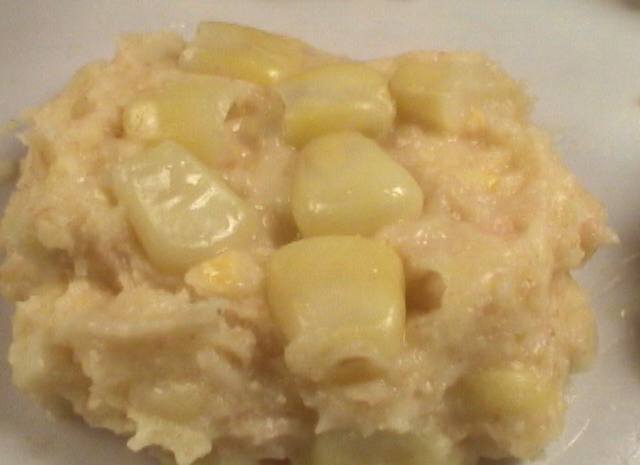
The photo below shows one of the toasted cookies. The top and bottom
surface layers are crispy, but the inside of the cookie is moist, and the
corn kernels are still juicy. When you eat these freshly baked cookies
while they are still warm, they are delicious!
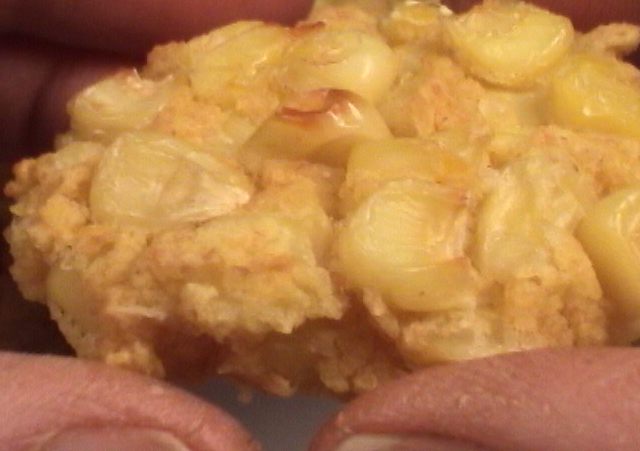
The photo below shows the bottom of the cookie, and you can
see that it is somewhat crispy on the bottom.
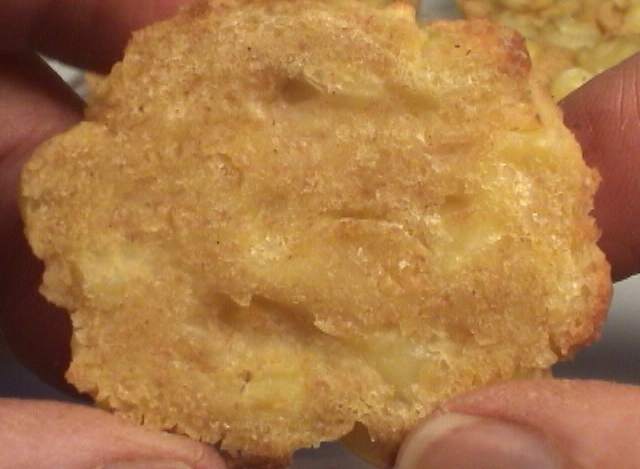
The idea of a cookie being made from whole grain millet and
corn, and without any sugar, might seem to be a joke, but try it!
Stevia and vinegar can make
dessert
pickles
Ordinary white vinegar that has been sweetened with Stevia
creates what I would describe as a "sweet and
sour vinegar". Those two ingredients, Stevia and white vinegar,
will transform some fruits and vegetables into delicious dessert
pickles.
|
For example, some people claim that the white part of a watermelon
rind is full of a valuable nutrients, but most people don't like the bland
flavor, so they discard that section of the watermelon.
IHowever, the rind can be transformed into a delicious "watermelon pickles"
or "watermelon relish" with a mixture of vinegar and Stevia. Simply cut
off the green part, which is supposed to be bad for our health, and then
slice or dice the rind. |
|
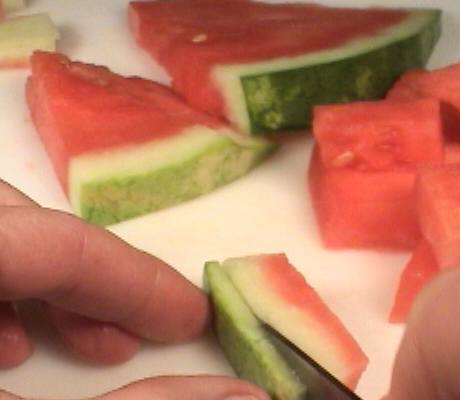 |
|
Then pour some of the sweet and sour vinegar onto it, and you end up
with what could be described as a "pickled watermelon rind dessert salad".
If you let the watermelon pieces soak for hours (or days), they will
absorb more of the vinegar, and then you can sprinkle them onto salads,
or use them on sandwiches, just as you would pickled cucumbers.
Compared to cucumber pickles, the watermelon pickles are much juicier
and crispier, and their flavor is a different, so if you enjoy variety,
you might enjoy using them once in a while. |
|
 |
|
You can also chop up the fruit portion of the watermelon in addition
to the rind. This creates a sweeter type of watermelon pickle, and it's
also softer and less crispy. The rind is much crispier. |
|
 |
Sweet and sour vinegar is an
excellent base
for sauces and dressings
It's very common for people, at least Americans, to use a mixture
of oil and vinegar as a base for salad dressings. To that base they might
add spices, lemon juice, cheese, or bacon bits. For me, a more useful base
is just a simple mixture of Stevia and white vinegar, which I described
above as a "sweet-and-sour vinegar". When the mixture is more sour than
sweet, it is like a typical salad dressing, but when it is made to be sweet,
it can transform a lot of vegetables, fruits, breads, and sandwiches into
desserts.
That sweet-and-sour vinegar is an excellent base for sauces
and dressings. It can be mixed with olive oil, cheese, lemon juice, grated
lemon rind, spices, or grated orange rind. For example, when mixed with
tumeric
powder, it creates a paste that reminds me of mustard.
It's not better than mustard; rather, it is simply a different variation
of a mustard. By varying the amount of Stevia, it can vary from a "sour"
mustard to a "sweet, dessert mustard".
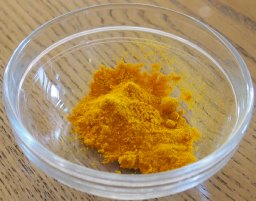
|
Tumeric Mustard
The photo on the left shows tumeric powder, and the photo on the
right shows the powder mixed with some white vinegar.
Add a bit of Stevia and you have a dessert
mustard. |
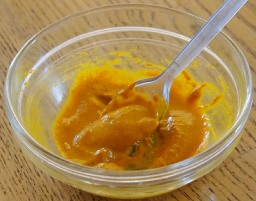
|
Sweet-and-Sour Cheese Sauces
By mixing cheese, either dairy or vegetarian, with a sweet
version of the Stevia/vinegar sauce I described above, you can create a
sweet-and-sour
cheese sauce that can be used in a variety of ways. For example,
mixing feta cheese with vinegar and Stevia will create a sweet-and-sour
feta cheese sauce that can be used as a pizza sauce or salad
dressing.
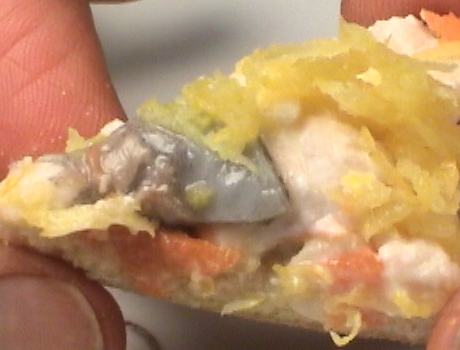
It does such an excellent job of transforming pizzas, sandwiches,
toast, and other items into a dessert, that I have
this page specifically for sweet-and-sour cheese dessert sauces. (The
photo shows a wedge of the pizza that you can find described at that page.)
It can also transform some of the bland vegetables, such as zucchini,
into a desert. I don't care much for zucchini, but I consider it to be
a delicious and healthy dessert when
chopped into cubes, toasted lightly, and then mixed with a sweet and sour
feta cheese sauce.
The sweet-and-sour cheese sauces can transform an enormous number of
items into deserts, at least for me.
How about you? Give it a try and find
out!
Raw fruit and vegetables
as desserts
Raw fruits and vegetables can be transformed into healthy desserts
simply by adding a little Stevia. A
lot of people are already sweetening carrot salads, coleslaw, pickled cucumbers,
and other raw fruits and vegetables with sugar, but by substituting some
or all of the sugar with Stevia, those fruits and vegetables become a dessert
that is much healthier. Furthermore, the Stevia doesn't interfere with
the flavor of the fruit, which makes it more flavorful.
People who have grown up on high sugar diets will find it difficult
to reduce their sugar level and use Stevia instead, but once a person gets
used to lower sugar levels, they are very likely to notice that fruits
and vegetables have a flavor. For some reason, sugar titillates us so much
that it can overpower the flavor of whatever it is sweetening. Since Stevia
doesn't have the sweetening ability of sugar, it's not very useful with
very bitter substances, such as chocolate, cabbage, lemon, or cranberries,
but in those cases, a mixture of Stevia and sugar can be very useful. Replacing
even a small portion of the sugar with Stevia will allow more of the flavor
of the food to come through, and it creates a healthier dessert.
A little bit of Stevia can make fresh fruit into a dessert by compensating
for the tartness that most fruits have. Even fruits that are already sweet
become more like a dessert with a little Stevia. For example, if you mash
a raw banana in a bowl, and then add a little Stevia, you can create a
sweet banana dessert. You can also cook a banana at a low temperature for
a brief period of time, as I show in this
video, and that will transform the banana into a "pudding" that is
much more delicious than the artificial banana puddings that the markets
are selling. Unfortunately, we don't yet have any honest medical researchers
helping us to understand whether the process of cooking is altering the
nutritional value of our foods.
Yams are another food that can be transformed into a dessert simply
by adding some Stevia to them. In that video in which I cook a banana at
a low temperature, I show that you can also cook yams at low temperature,
and this retains all of its juice. By cutting or mashing the yam, and adding
some Stevia, it becomes a sweet dessert. For variety, add other ingredients
for flavor, such as grated orange rind and orange juice, or butter, molasses,
and raisins, or cinnamon and apples.
If the sweet banana or yam mixture is used as a filling for donuts that
have been made from freshly ground, whole grains, the end result could
be described as banana or yam jelly donuts, but they would be healthy!
Or, if the sweet banana or yam mixture is spread onto flat pieces of bread,
they could be described as "banana cookies", or "yam dessert pizzas".
Doughnuts could be made from
healthy ingredients
What is a "doughnut"? Before answering that question, let's
get rid of the silent letters and write "donut".
In America, most donuts are a piece of nutritionally worthless, tasteless,
white flour, mixed with some oil, artificial flavors, overcooked fruit,
and/or some type of nutritionally worthless but very sweet topping.
We could make donuts from healthy ingredients. For example, instead
of using refined white flour, donuts could be made from freshly ground,
whole grains. And instead of a topping of flavored sugar, or instead of
a filling a donut with overcooked fruit that has been sweetened with large
amounts of sugar, we could make toppings and fillings from healthy
ingredients. Instead of filling a jelly donut with worthless jelly, it
could be filled with a sweet-and-sour feta cheese sauce that is full
of lemon rind, grated carrots, and sprouts.
Note, in the photos, I am using flat pieces of bread because I
don't bother trying to make the fancy circular donuts with holes, or the
even more fancy twisted donuts. It's much easier to make flat bread.
The shape of the donut is irrelevant. The point I'm trying to make is that
the combination of Stevia with freshly baked, freshly ground whole-grain
bread with healthy toppings or fillings will create a donut that is healthy,
tasty, and sweet.
Another, perhaps more bizarre mixture that can be used as a filling
or a topping for donuts is a mixture of Roquefort cheese with Stevia and
vinegar, and some pieces of tomato. This could be described as a sweet-and-sour
Roquefort cheese tomato donut. Or, since I put it on a flat piece of bread,
it could be described as a sweet-and-sour Roquefort cheese tomato sandwich
or pizza.
The filling of a donut doesn't need any strength, and this allows a
lot of healthy fillings. For example, cook some millet into a thick paste,
and then add some raw or lightly cooked corn kernels and some Stevia. You
could also add some olive oil or butter. The result is a sweet millet corn
filling, and this is excellent in a donut made with whole-grain Kamut.
Incidentally, this millet corn filling can be eaten all by itself. It could
be described as a sweet, millet corn pudding.
Low temperatures can transform
some fruits into desert
My white peaches ripen at almost the same time, and so I cannot
eat all of them as they ripen, but when I cut them up and put them in the
freezer to save them, not even the freezing process, or the addition of
vitamin C, can stop them from turning brown. Raw bananas also turn brown
even while frozen. It would be nice if our society would study this issue
of brown discoloration and determine if it's an insignificant visual effect,
or if we should be concerned about it. Anyway, in the meantime, I've discovered
that if I heat peaches, bananas, and certain other fruit to a low temperature,
somewhere in the range of 48°C to 60°C (120°F to 140°F),
then the fruit will remain in its natural color for a longer period of
time.
|
As I explained in this
video, bananas and apples are also excellent when cooked at a low temperature.
If you let the banana get slightly brown, it creates a somewhat firm but
sweet banana pudding, and if you let the banana turn black, it becomes
even sweeter and more liquid, and after stirring it up, you end up with
a sweet banana sauce. |
|
 |
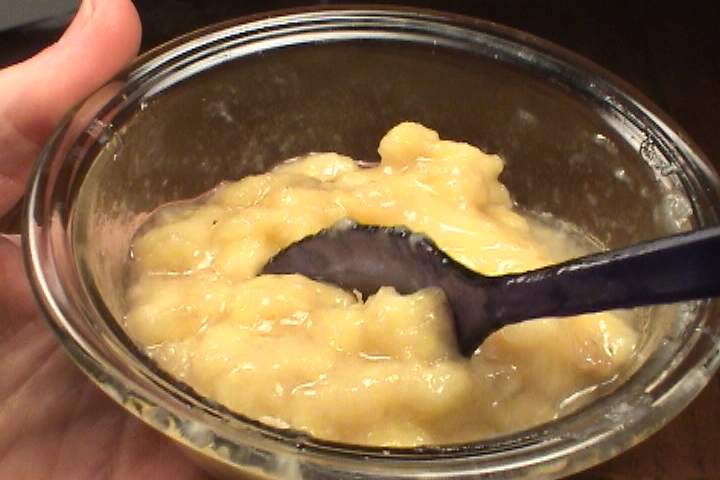
Furthermore, heating some fruits up to that temperature causes them
to become sweeter. This is another issue that society ought to study. What
happens when fruit as it is heated to various temperatures? At what point
are beneficial enzymes or nutrients destroyed? Does the heat create more
sugar, or does it destroy some of the bitter chemicals?
Anyway, in the meantime, we can turn a lot of fruits into desserts simply
by heating the fruit to a low temperature. Furthermore, adding a bit of
Stevia to the fruit will make it even more like a dessert without interfering
with the flavor of the fruit or adding more sugar to it. If the nutrients
can survive the low temperature cooking, then this is yet another method
of providing ourselves, and children, with desserts that are both sweet
and healthy.
Other techniques to make
fruit into a desert
One of the problems with raw fruit is that they are inconsistent.
For example, some apples and peaches are very tasty, while others are sour,
watery, or bland. Therefore, a rather obvious technique to make fruit into
a more desirable dessert, especially for children, is to slice all of the
fruit into pieces, heat the slices to a low temperature, and then give
each person a mixture of those slices. The best tasting fruit will help
compensate for the bland fruit, and the heating process will make all of
the fruit noticeably sweeter, thereby making the fruit into a desert that
everybody, especially children, will find much more enjoyable.
This photograph shows some of my white peaches in a cast-iron skillet,
after I heated them to a low temperature, and with the addition of vitamin
C. They are so much more delicious than the peach pies, or chocolate cakes,
I think they are much more delicious than the peach pies, chocolate cakes,
or other desserts that are produced by factories.
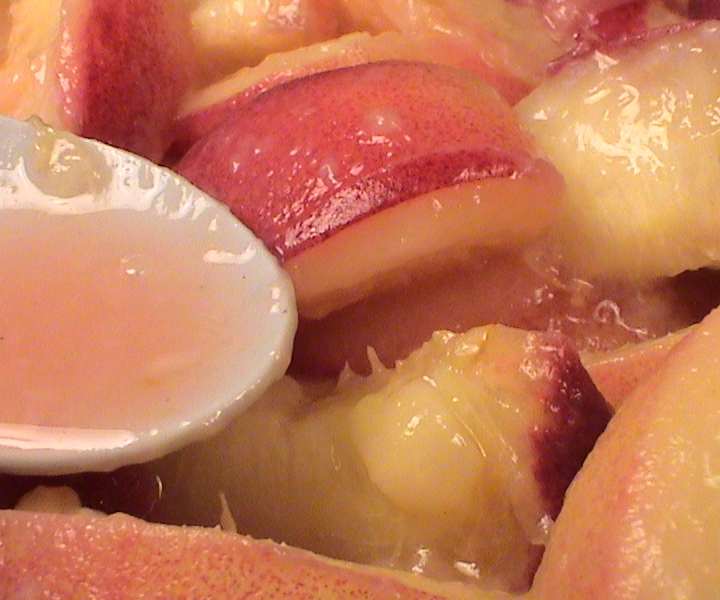
Some fruit ripen when kept warm
I don't know how many fruits this technique works for, but
I've been doing this with figs for few decades. Specifically, after I picked
figs, I put them in a warm location for a few hours, up to two days, so
that they can be between perhaps 37°C to 43°C (100 to 110°F).
When I had an oven with a pilot light, I would put them in the oven, but
now I have to put them in a sunny window. Perhaps because figs evolved
for hot deserts, the very warm temperatures cause the fig to continue to
ripen. They taste much better after this ripening process. This photo shows
four wrinkled figs, which are two days old, with three smoother figs that
are only one day old. The figs often get dry and wrinkly on the outside
during the ripening process, but they remain juicy on the inside.
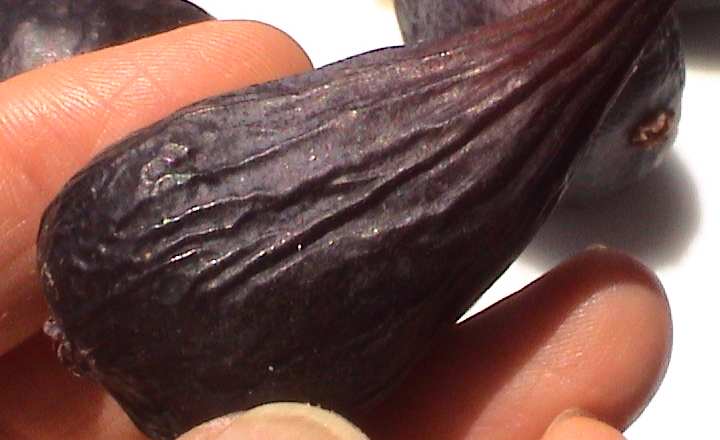 The fig tree evolved in a hot climate, so perhaps that's why
figs continue to ripen when maintained at warm temperatures.
In this photograph, I mixed a tiny bit of powdered Stevia with water,
and then sliced those four, very ripe, wrinkly figs into it, and then stired
the slices give them a coating of the sweet liquid. The result was a delicious,
sweet, fig dessert that is completely raw and natural.
Conclusion about desserts
Desserts don't have to
be a mixture of worthless, tasteless, refined white flour with oil, artificial
flavors, and overcooked, tasteless fruit. We can make an amazing variety
of healthy desserts simply by making the desert from freshly ground, whole-grains,
raw or lightly cooked fruits and vegetables, and by replacing at least
some of the sugar with Stevia. By producing these type of desserts, parents
don't have to worry about their children eating large amounts of sweet
carrot salads, sweet coleslaw, sweet pickled cucumbers, or sweet pickled
watermelon.
|